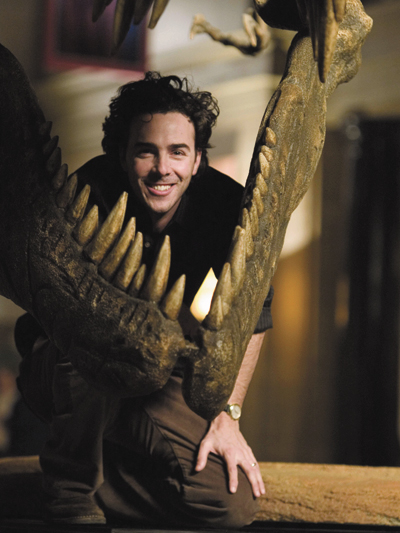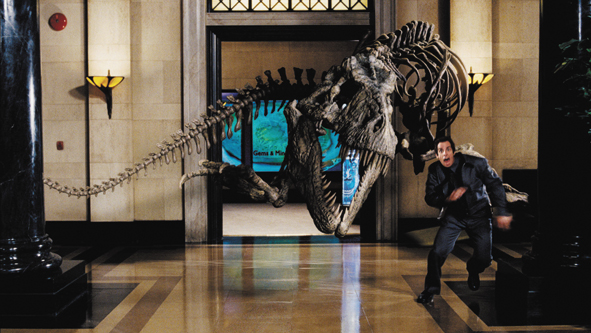BY SHAWN LEVY
 NOISES OFF: Shawn Levy would make dinosaur sounds
NOISES OFF: Shawn Levy would make dinosaur sounds
off-camera to help his actors play their scenes.
(Credit: Doane Gregory/20th Century Fox)
Years ago, when I was an undergraduate in the drama program at Yale, I spent a semester in an acting class taught by the esteemed theater director Nikos Psacharopoulos. One day during class, I performed a scene from Tennessee Williams' Vieux Carré. I got about 10 lines into the scene when, suddenly, I heard: "Stop! Stop! Please, stop!" It was Nikos.
"Shawn," he said to me, "I can see that you know what is required of the scene, of the performance, but you aren't getting yourself there. Because you are watching yourself trying to get there. Perhaps," he added, with forced diplomacy, "you should consider directing. That way, you could use your instincts to do what a director must do: lead actors to where they need to be."
Now, one could legitimately argue that as an 18-year-old Jewish Canadian, I had no business whatsoever attempting the dulcet southern rhythms of an obscure Tennessee Williams piece. Yet beyond that, I saw in Nikos' words a valid and lasting lesson. No, not just the not-so-subtly suggested career change, but something more: A glimmer into the heart of our job as directors, which is to help actors get to the performance we both want.
Early on in my career when I was directing television, I worked frequently with child and adolescent actors, and found myself improvising new techniques for helping them. Specifically, I developed an obstinate resistance to ever yelling "Cut!" unless absolutely necessary. I quickly learned that the deflation and scattered energy that can fill the space between "Cut" and the next "Action" was death to a young performer's focus. It is impossible to compete with the allure of a Game Boy, sugary snacks at the craft service table, as well as combating the dreaded acting notes from Mommy. In fact, I frequently found that in the time it took to roll sound, smack a slate and yell "Action!" the young actor would completely forget the note I had given him only 20 seconds earlier between takes. Consequently, I developed a rhythm with kid actors whereby we would slate a take, I would then run into the shot, whisper the note in the kid's ear, run out and call "Action!" Not only did I get some needed exercise, the note was fresh and often actually applied.
This style inevitably led to an approach employed by many directors—and especially comedy directors, I've noticed—the ol' "Don't-cut-unless-you-really-have-to-and-instead-just-call-out-adjustments-and-alternative-lines-or-jokes-within-the-take." This approach can be highly effective, as it keeps everyone coiled, sharp and on their toes. It was particularly helpful on my movie Cheaper by the Dozen, where I had a multitude of receptive young actors who were only too happy to try alternate lines I threw at them from the monitor. The only misfire was when I asked the five-year-old Kinsman Twins to try a handful of new jokes while they had fake puke (oatmeal, really) smeared on their faces. I think the lesson there is that no one likes being covered with vomit (even fake vomit), and that when a five-year-old has had enough, he's had enough; your directorial authority is irrelevant. This technique of trying adjustments within the take, by the way, is quite loathed by film footage–obsessed line producers and carpal–tunneling script supervisors trying to keep up with insane multitudes of different versions.
Bottom line, my experience directing has opened me up to a wide range of approaches to coaxing the desired performance from an actor. No film has proven quite as unconventional in this regard, as my last one, Night at the Museum. The film is about a night guard at a natural history museum, who is forced to contend with all the museum's exhibits coming to life after dark. Going into the picture, I thought that the hard part was going to be the complexity of visual effects that would be needed to bring the movie to life. Little did I know that it wasn't the effects that would prove most daunting; it was the off-camera shenanigans that would evolve as an integral part of making the film.
It all started on the day we shot Ben Stiller's character, Larry, seeing, for the first time, a massive T-Rex skeleton drinking from the museum water fountain. I had vigilantly storyboarded the sequence, and panels of drawings were tacked up on poster boards around the set. Pre-vis'd sections of the scene were available on a dozen laptops, ready and waiting to show the scene as it had been designed in my head. Every angle, every focal length, every technical measurement and inch of negative space had been accounted for and there we were, ready to make a movie. Yet we had forgotten to account for one critical piece. The cameras rolled, the slate was smacked, "Action" was called, and then it hit me: This was one weird way to do a movie.
We had close to 200 crewmembers standing around, quietly watching while Ben Stiller was asked to simulate true, deep (yet still comedic) terror—while staring at nothing. Well, not quite nothing—he did have a tennis ball on a C-stand to react to. So I did what I felt I had to do for my actor: I wheeled in a ladder right next to the camera, stood on the top step, and as I called "action," I curled both my hands into would-be talons in front of my chest. As Ben rounded the corner to face the non-existent T-Rex, I slowly turned toward him with a hideous (and, I thought, petrifying) grimace—and I roared. Not just a little roar, either. I'm talking a big, loooooong, Jurassic-style roar.
It was weird, it was embarrassing, it was probably fodder for a dozen text messages from crew members to their buddies regarding the freak director who had just channeled a dinosaur—but it worked. Okay, not right away, maybe, but after Ben and the crew had finished laughing at me, we realized we had found an approach that would become an intrinsic component of our shoot. Day after day, as the cast was forced to show up and react to things that weren't actually there, we found it helpful to have them react to something real (me, in an array of unflattering off-camera permutations) in the midst of wildly unbelievable circumstances.
 AFTER HOURS: Ben Stiller is a night guard at a natural history museum trying
AFTER HOURS: Ben Stiller is a night guard at a natural history museum trying
to cope with strange doings in Night at the Museum. (Credit: Rhythm & Hues)
And thus, our not-yet patented technique of the Off-Camera Humiliation was born. Some days I went to work and played that skeletal prehistoric beast. Other days, I channeled a ferocious lion, a soaring hawk, a bellicose moose, a stone Easter Island head or a mischievous capuchin monkey. (In fact if you listen to the film, 90 percent of those simian sounds are actually me, deep in primate character.)
Now, with a year's distance from shooting Night at the Museum, I can look back fondly—not just due to the success of the film, but to the performances throughout. My cast, led by Ben Stiller, somehow preserved a naturalism and honesty in the midst of chaotic spectacle and complex visual effects. And while this achievement is almost certainly due to the incredibly talented actors onscreen, I'd like to believe it's also due in some small part to my teacher Nikos, who taught me the most important part of my job—to do whatever I must to give my actors what they need.
Even if it means making a complete and utter ass of myself to do it.